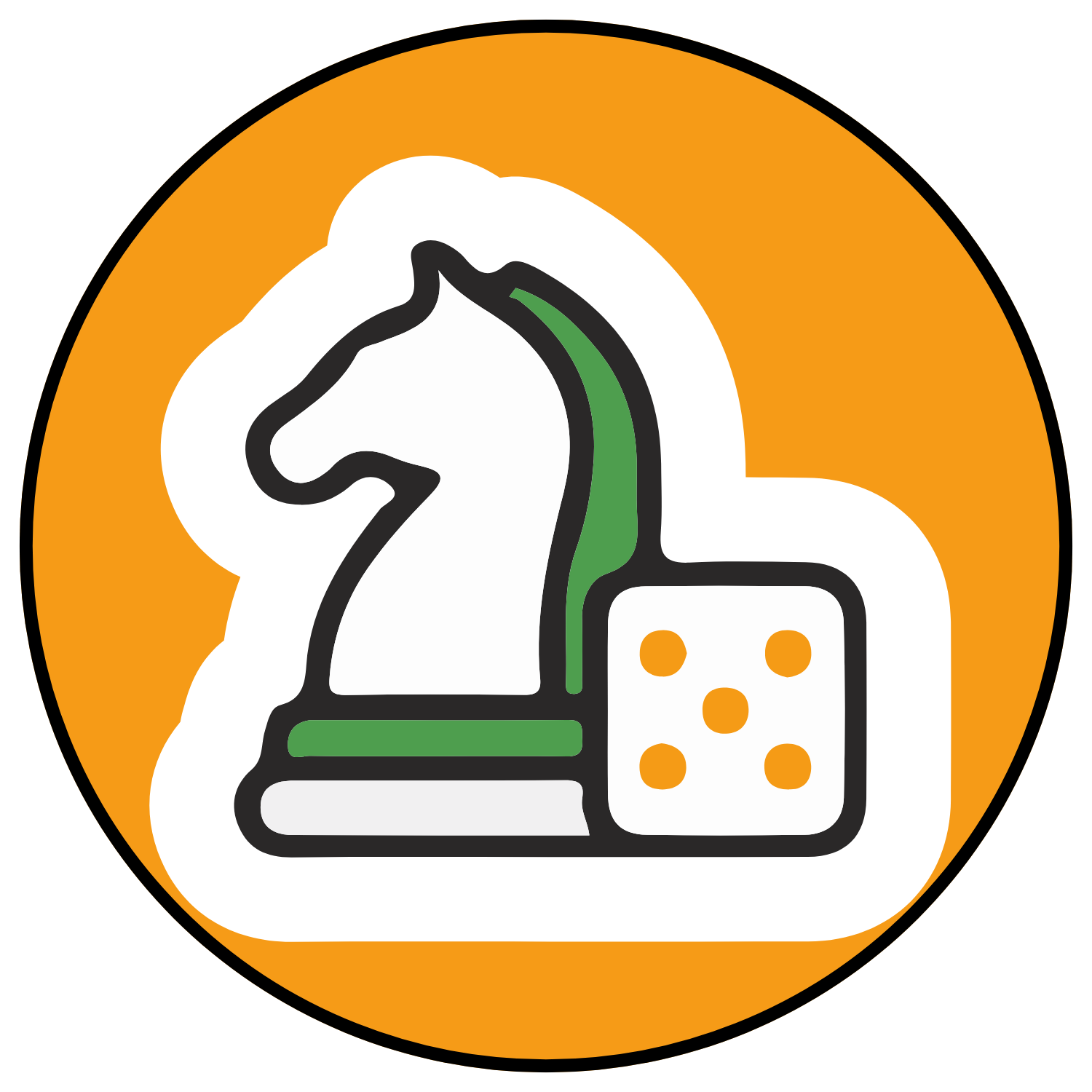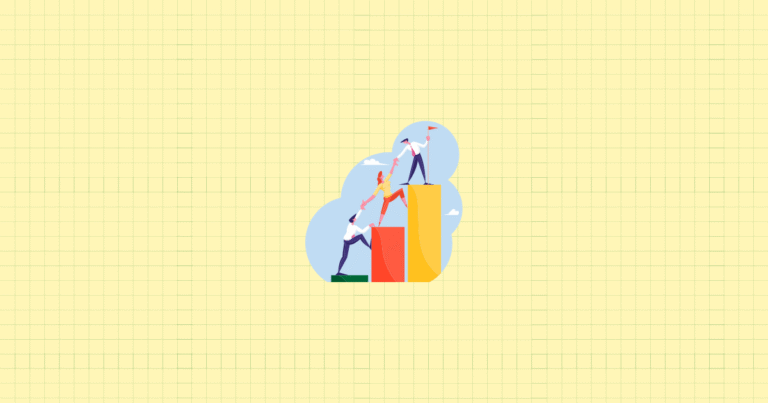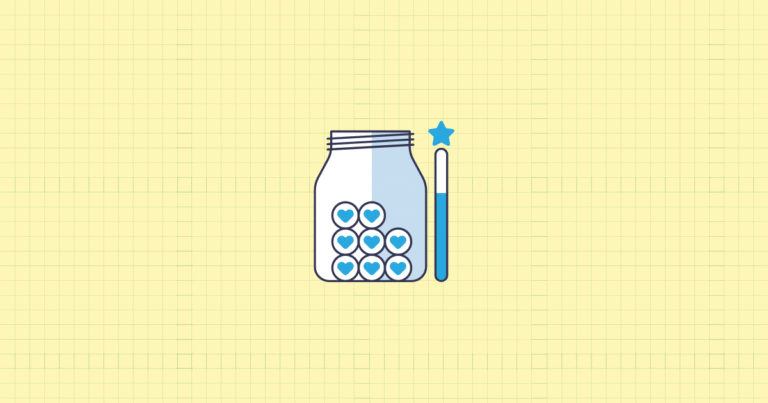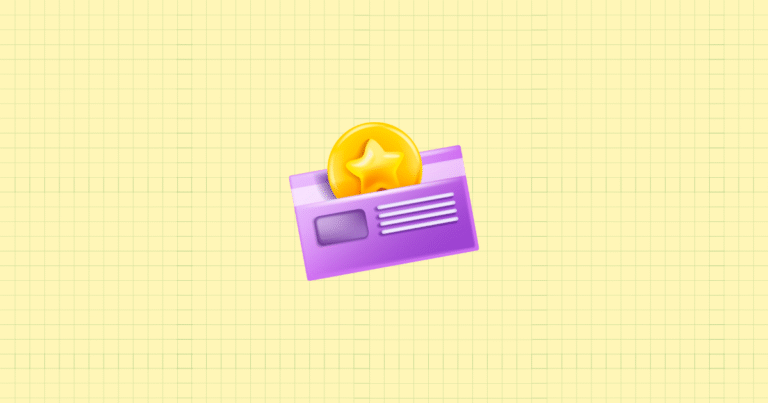Introduction: The Discount Dilemma
Ever notice how a 20% discount that once excited your customers barely gets a reaction now? You’re not alone. The thrill is gone—replaced by expectation. And that’s a problem.
In today’s crowded e-commerce landscape, the standard discount playbook is failing Shopify store owners in ways that go beyond shrinking profit margins. Your customers are drowning in a sea of sameness. 10% off. 15% off. Free shipping. Repeat. The result? An audience trained to wait for sales rather than value your products at full price.
But what if the answer isn’t more aggressive discounting but something entirely different? Something that creates genuine excitement, fosters real connections, and protects your hard-earned brand value?
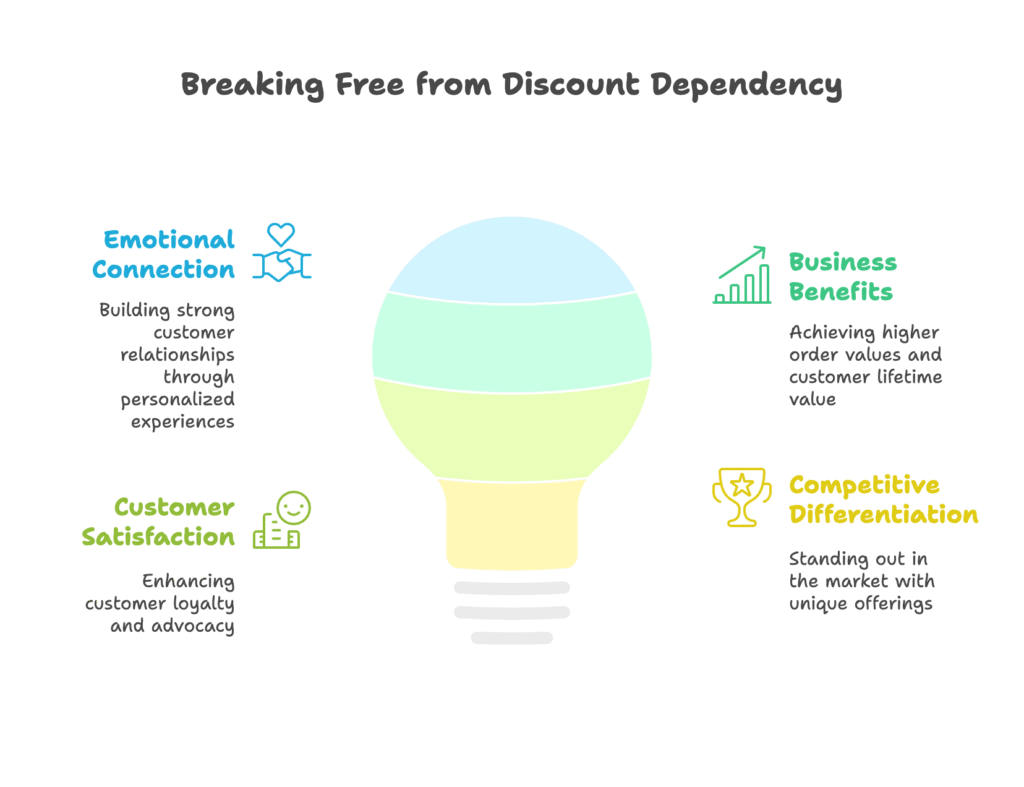
The Limitations of Discount-Only Reward Systems
The Problem of Discount Fatigue
Remember when a 10% discount code felt special? Those days are long gone. Your customers are increasingly desensitized to percentage-off offers that once drove immediate action. Each “exclusive” discount becomes less effective than the last, creating a downward spiral where deeper cuts become necessary to generate the same response.
This discount fatigue isn’t happening in isolation. Your competitors are playing the same game, creating a marketplace where price slashing is the norm rather than the exception. Standing out becomes nearly impossible when everyone’s racing to the bottom.
But the real danger runs deeper than diminishing returns on your marketing efforts.
The Business Impact of Discount Dependency
When discounts become your primary customer incentive, you’re not just sacrificing immediate profit margins—you’re reshaping customer behavior in potentially harmful ways. Savvy shoppers learn to play the waiting game, holding off purchases until your next inevitable sale.
The consequences ripple through your business:
- Unpredictable revenue cycles with feast-or-famine sales patterns
- Decreased perceived value of your products and brand
- Attracting price-sensitive customers rather than value-oriented brand advocates
- Creating an unsustainable cycle requiring ever-deeper discounts
A fashion boutique owner I worked with discovered this the hard way. After six months of regular 20% off promotions, her once-reliable full-price customers disappeared. Sales came in waves—massive during promotions, nearly nonexistent between them. “I’ve trained my customers to wait,” she told me. “Now I’m stuck in a discount trap I can’t escape.”
The Strategic Value of Creative Rewards
What if there was a way to delight customers without slashing prices? To create the rush of getting something special without conditioning people to devalue your products?
Building Emotional Connection vs. Transactional Relationships
At its core, creative rewarding is about shifting from purely transactional exchanges to relationship building. When a customer receives a surprise gift with purchase that perfectly complements what they ordered, the emotional impact far exceeds the equivalent percentage discount.
These emotional connections transform one-time buyers into genuine brand advocates. A customer who feels recognized and appreciated shares their experience with friends, family, and social networks—delivering organic marketing that no discount code can match.
And while discounts feel forgettable and expected, creative rewards create stories worth telling.
Business Benefits Beyond Customer Satisfaction
The shift from discount dependency to creative rewarding isn’t just about customer psychology—it delivers concrete business advantages:
- Higher average order values as customers pursue rewards rather than wait for sitewide sales
- Increased customer lifetime value through stronger brand affinity
- Improved engagement with marketing communications as messages shift from “sale” to “exclusive opportunity”
- Clear differentiation in the competitive Shopify marketplace
The impact is measurable. When specialty tea retailer TeaVana replaced their standard 15% off loyalty program with exclusive early access to seasonal collections and custom tea blending sessions, their repeat purchase rate increased by 24%, and their average order value grew by 18% over six months.
Ready to break free from the discount dependency cycle? Let’s dive into the psychology that makes creative rewards so effective.
Understanding Reward Psychology for Shopify Customers
Ever wonder why some rewards generate genuine excitement while others barely register? The answer lies in understanding what truly motivates your customers beyond simple savings.
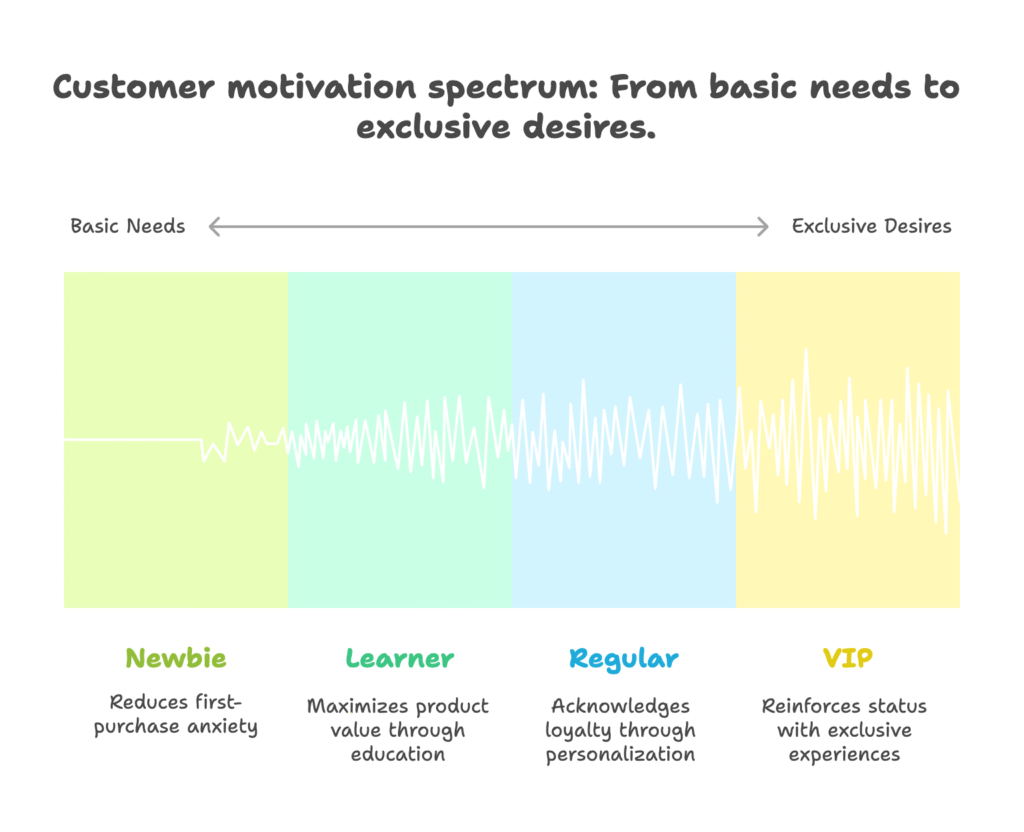
Motivation Factors in Customer Loyalty
Behind every purchasing decision lies a complex mix of practical needs and emotional desires. Tap into these deeper motivations, and you’ll create loyalty that transcends transactional relationships.
The Psychology of Exclusivity and Status
We’re hardwired to value what’s scarce and exclusive. A reward that makes customers feel like VIPs activates powerful status-seeking behaviors that straight discounts simply cannot match.
This desire for special treatment manifests in several ways:
- The thrill of being “in the know” about something not available to everyone
- FOMO (Fear Of Missing Out) when exclusive opportunities have limited availability
- The social status boost that comes from membership in exclusive groups
Consider how Sephora’s Beauty Insider program creates tiers with increasingly exclusive perks. Their top “Rouge” members don’t just get deeper discounts—they receive invitations to private events, early access to products, and free custom beauty services. These status markers create powerful motivation to maintain their position in the hierarchy.
Value Perception Beyond Monetary Discounts
The perceived value of a reward often exceeds its actual cost when it delivers an experience or recognition that money can’t easily buy.
A $50 product received as a gift can create more goodwill than a $50 discount because:
- It feels like a genuine gift rather than a transaction
- The customer doesn’t have to calculate the value—they experience it directly
- The surprise element creates a dopamine response that enhances memory and positive association
When outdoor retailer REI invites their Co-op members to members-only garage sales or classes, they’re providing value that transcends simple price reductions while strengthening community bonds.
Segmenting Your Shopify Store Audience
Not all customers value the same rewards. Understanding the distinct preferences of different customer segments allows you to create rewards that resonate deeply with each group.
Tailoring Rewards to Customer Segments
Your Shopify store likely serves customers at different stages of their relationship with your brand. Each segment has distinct needs and motivations:
- Starter customers (new to your store): Value low-barrier entry rewards that reduce first-purchase anxiety, such as risk-free trials or small welcome gifts
- Beginner customers (made initial purchases): Appreciate educational content and community integration that helps them get maximum value from products
- Intermediate customers (established relationship): Respond to recognition and personalization that acknowledges their ongoing loyalty
- Advanced customers (high-value, frequent buyers): Desire exclusive experiences, early access, and VIP treatment that reinforces their special status
A skincare brand I consulted with created a tiered rewards program with this segmentation in mind. New customers received sample kits with their first purchase. Regular customers gained access to expert video tutorials. Their most loyal customers received personalized skincare consultations and early access to limited collections. Each reward addressed the specific needs and desires of that customer segment, creating targeted motivation to move up the loyalty ladder.
Aligning Reward Strategies with Purchase Behavior
Beyond segmenting by relationship stage, effective rewards programs consider specific customer behaviors:
- First-time purchase incentives: Reduce initial purchase barriers with low-risk trials or added-value welcome kits
- Repeat purchase rewards: Create progressive benefits that increase with purchase frequency
- High-value customer recognition: Acknowledge and reward customers who consistently make larger purchases
- Re-engagement campaigns: Entice dormant customers back with “we miss you” privileges or time-limited special access
Now that we understand the psychological foundations of effective rewarding, let’s explore specific creative reward types you can implement in your Shopify store.
Five Creative Reward Types for Shopify Stores
Wondering what kinds of non-discount rewards actually work? Here are five proven approaches that create genuine excitement while preserving your brand value.
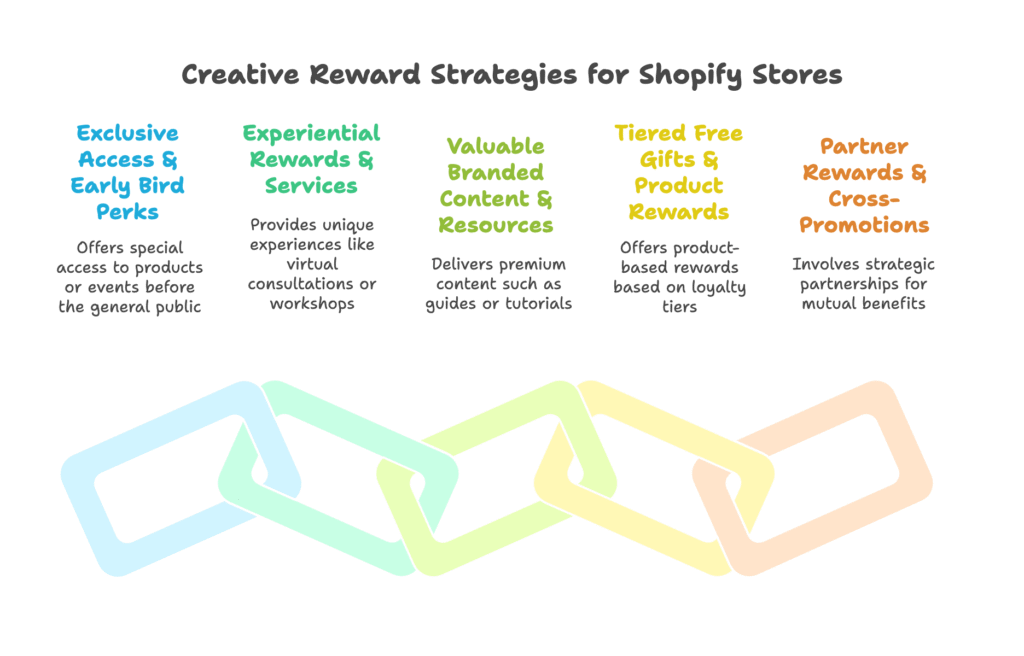
Exclusive Access & Early Bird Perks
Nothing creates desire quite like exclusivity. When you offer special access to products, events, or information before they’re available to the general public, you tap into powerful psychological triggers that create both immediate satisfaction and long-term loyalty.
Implementation Strategies
Exclusive access can take many forms, each creating different kinds of value:
- Pre-launch product access: Give loyalty members first opportunity to purchase new products or collections
- Early access to sales events: Provide a 24-48 hour head start on popular sales before opening to everyone
- Limited edition items: Create special products available only to program members
- Behind-the-scenes content: Share product development stories, founder insights, or creative processes
Athleisure brand Gymshark masterfully uses this approach by giving their “Gymshark Family” members early access to limited drops, creating both exclusivity and urgency. These releases often sell out during the early access period, reinforcing the value of membership.
Technical Setup on Shopify
Implementing exclusive access in your Shopify store is simpler than you might think:
- Use customer tags to segment loyalty members (accessible via Shopify admin or loyalty apps)
- Create targeted email campaigns announcing exclusive opportunities (using Klaviyo, Omnisend, or other ESP)
- Utilize password-protected pages for member-only products or collections
- Leverage loyalty app tier systems to automate access based on customer status
Pro tip: Create a clear, visible calendar of upcoming exclusive access opportunities to maintain engagement and give members something to look forward to.
Experiential Rewards & Services
While products can be compared and discounted, experiences create unique value that customers can’t easily find elsewhere. Service-based rewards often cost less to provide than product discounts while delivering higher perceived value.
Service-Based Reward Options
Consider these experiential rewards that create memorable connections with your brand:
- Virtual consultations: Offer personalized shopping assistance, product recommendations, or usage guidance
- Members-only workshops: Host educational sessions related to your product category
- Q&A sessions: Create opportunities for customers to interact directly with founders, designers, or experts
- Custom product configurations: Provide special customization options exclusive to loyalty members
A home cooking brand I worked with launched virtual cooking classes with their product development chef as a reward for their top-tier customers. The classes consistently had 90%+ attendance rates, and participants spent an average of 40% more in the following month compared to non-participants.
Implementation Considerations
Successfully executing experiential rewards requires careful planning:
- Define clear parameters for service-based rewards, including time limits and scope
- Establish point values or achievement thresholds that make the rewards attainable but exclusive
- Create streamlined booking and fulfillment processes to ensure positive experiences
- Train team members to deliver consistent quality during reward experiences
When implementing experiential rewards, start small with a pilot program to test operational capacity before expanding offerings.
Valuable Branded Content & Resources
Content rewards cost little to produce at scale but can deliver substantial value when they help customers solve problems or achieve goals related to your products.
Content Reward Types
Effective content rewards go beyond basic blog posts to deliver premium value:
- Downloadable guides and e-books: Comprehensive resources that address complex topics related to your product category
- Exclusive video tutorials: In-depth instructions or creative inspiration for product usage
- Templates and tools: Digital resources that complement your physical products
- Advanced product usage guides: Expert-level techniques and insights not available in standard documentation
Craft supply retailer Michaels offers exclusive project templates and instructional content to their rewards members, creating ongoing engagement and driving repeat purchases of necessary supplies.
Delivery Methods on Shopify
Distributing exclusive content to the right customers can be automated through several methods:
- Email automation workflows triggered by purchase or point thresholds
- Password-protected site sections accessible only to loyalty members
- Integration with content management systems like Kajabi or Teachable for more robust educational content
- Member-only mobile app sections for on-the-go access
For maximum impact, ensure your content rewards are mobile-friendly and easily accessible across devices.
Tiered Free Gifts & Product Rewards
Product-based rewards create tangible value without the brand-damaging perception of discounting. The key is selecting items that complement purchased products while introducing customers to new offerings they might purchase later.
Product-Based Reward Strategy
Effective product rewards follow several patterns:
- Full-sized product rewards: More impactful than samples, these create substantial perceived value
- Curated product bundles: Collections of complementary items that enhance the primary purchase
- Limited edition products: Special items not available for regular purchase
- Progressive gifting: Increasingly valuable product rewards based on loyalty tier status
Cosmetics brand Glossier offers limited-edition merchandise like tote bags and accessories as rewards, creating collectible items that customers proudly display—extending brand awareness while delighting loyal customers.
Logistical Considerations
Successfully implementing product rewards requires attention to operational details:
- Inventory management systems that track reward products separately from regular inventory
- Clear point values or spending thresholds aligned with reward product costs
- Automated systems for adding gift products to qualifying orders
- Training for fulfillment staff to ensure proper inclusion of reward products
Pro tip: Create special packaging or presentation for reward products to enhance the “gift” feeling and differentiate from purchased items.
Partner Rewards & Cross-Promotions
Strategic partnerships allow you to offer high-value rewards at reduced cost while introducing your customers to complementary brands and products.
Building Effective Partnerships
The right partnerships create win-win-win scenarios for you, your partners, and your customers:
- Complementary, non-competing Shopify brands: Seek businesses with similar customer demographics but non-competing products
- Mutually beneficial reward exchanges: Create reciprocal arrangements where each partner provides rewards for the other’s customers
- Local business collaborations: Partner with nearby businesses for location-based rewards (especially valuable for Shopify stores with physical locations)
A men’s grooming products company I consulted with partnered with a premium sock subscription service. Their top-tier customers received a free month of the sock subscription, while the sock company’s customers received grooming product samples. Both companies gained exposure to highly-qualified potential customers while providing high perceived value rewards.
Implementation Approaches
Executing partner rewards requires clear communication and tracking:
- Establish distinct promo codes or referral links for tracking cross-promotion effectiveness
- Create clear customer communication about how to redeem partner benefits
- Develop systems for regularly exchanging redemption data with partners
- Schedule quarterly reviews to assess partnership performance and make adjustments
Now that we’ve explored creative reward options, let’s examine how to implement them effectively in your Shopify store.
Implementing Creative Rewards on Your Shopify Store
Ready to move beyond discounts? Here’s how to build a technical foundation for your creative rewards program using Shopify’s capabilities and third-party solutions.
Evaluating Loyalty Program Solutions
The right technology stack makes implementing creative rewards significantly easier. Your options range from Shopify’s native capabilities to specialized third-party applications.
Native Shopify Capabilities
Shopify offers several built-in features that support basic rewards programs:
- Customer accounts and tags: Allow basic segmentation of customers for targeted rewards
- Discount codes: Support traditional discount-based rewards but with limited automation
- Customer groups: Enable creation of customer segments with specific access or pricing
However, native capabilities have significant limitations:
- Limited automation for reward distribution
- No built-in points accumulation system
- Minimal options for experiential or partner rewards
- Manual management required for most creative reward types
Third-Party Loyalty App Assessment
For more robust rewards programs, third-party apps provide essential functionality:
- Cevoid: Particularly strong for engagement-focused programs with excellent options for experiential rewards and exclusive access
- Loyalty Wizard: Offers highly customizable reward structures supporting all five creative reward types discussed earlier
- SC Loyalty Rewards: Provides robust points-based program capabilities with strong analytics
When selecting a loyalty solution, consider these key integration factors:
- Compatibility with your existing tech stack (email platform, CRM, etc.)
- Mobile experience for program members
- Analytics capabilities for program performance tracking
- Flexibility to support your specific creative reward types
A specialty food Shopify store I worked with initially tried managing their creative rewards program manually but switched to Loyalty Wizard after three months. The automation reduced their administrative time by 85% while improving program consistency and customer satisfaction.
Points-Earning Mechanisms
While your rewards might not be discounts, you’ll still need a “currency” to determine who receives what rewards. Points systems create flexibility in reward distribution while gamifying the customer experience.
Purchase-Based Points Structures
Traditional spending-based points remain an effective foundation:
- Basic point-per-dollar spent: Simple to understand but may favor only high-spending customers
- Product-specific bonus points: Drive sales of specific items by assigning higher point values
- Tier multipliers: Reward VIP customers with accelerated points earning (e.g., 2x points for gold tier members)
For maximum effectiveness, make points values intuitive (e.g., 1 point = $1 in reward value) rather than requiring complex mental math.
Engagement-Based Points Opportunities
Expand beyond purchase-based points to reward valuable non-purchase behaviors:
- Account creation and profile completion: Reward initial engagement and data sharing
- Birthday celebrations: Offer annual points bonuses to maintain program engagement
- Social media engagement: Award points for following, sharing, or creating user-generated content
- Product reviews: Incentivize reviews with points while generating valuable social proof
- Referrals: Reward customers for bringing new shoppers to your store
Outdoor equipment retailer REI awards points not just for purchases but for participation in environmental cleanup events and product recycling programs, aligning rewards with their brand values while encouraging non-purchase engagement.
Creating Effective Tiered Programs
Tiered programs create aspirational goals for customers while allowing you to focus your most valuable rewards on your best customers.
Tier Structure Design
Effective tier structures balance accessibility with exclusivity:
- Appropriate tier thresholds: Create attainable initial tiers with more exclusive upper tiers
- Meaningful tier names: Develop tier names that reflect your brand identity rather than generic “Silver/Gold/Platinum” labels
- Clear visibility of progress: Show customers how close they are to reaching the next tier
Beauty retailer Sephora’s Beauty Insider program uses makeup-relevant tier names (Insider, VIB, and Rouge) with clearly defined benefits for each level, creating strong motivation to reach the next tier.
Differentiated Benefits by Tier
The key to effective tiering is ensuring each level offers distinctly better benefits:
- Progressive rewards: Increase the value and exclusivity of rewards at higher tiers
- Exclusive upper-tier benefits: Reserve your most premium experiences for top-tier members only
- Maintenance requirements: Consider whether customers maintain tier status permanently or need to requalify periodically
With your reward program structure in place, how do you know if it’s actually working? Let’s look at measurement and optimization.
Measuring and Optimizing Creative Rewards
Even the most creative rewards program needs proper measurement and continuous refinement. Here’s how to ensure your program delivers meaningful business results.
Key Performance Indicators
Effective measurement starts with tracking the right metrics for both program health and business impact.
Program Health Metrics
These indicators reveal how well your rewards program itself is functioning:
- Enrollment rate: Percentage of customers who join your program
- Active participation rate: Percentage of members who engage with the program regularly
- Points earned vs. redeemed: Ratio indicating program engagement (low redemption may indicate unappealing rewards)
- Program cost as percentage of revenue: Ensures reward expenses remain proportional to generated revenue
Tracking these metrics provides early warning signs of program issues before they impact broader business performance.
Business Impact Metrics
Ultimately, your rewards program should positively influence these key business metrics:
- Repeat purchase rate: Are program members buying more frequently than non-members?
- Average order value: Do members spend more per order than non-members?
- Customer lifetime value: Is the program extending customer relationships and total spending?
- Retention rate by segment: Is the program reducing churn, particularly in high-value segments?
A home decor brand I worked with discovered their creative rewards program increased repeat purchase rate by 32% and average order value by 18% compared to non-members, justifying continued investment in premium reward experiences.
Testing and Refinement Strategies
No rewards program is perfect at launch. Continuous testing and optimization are essential for long-term success.
A/B Testing Reward Offerings
Systematic testing reveals which rewards create the strongest response:
- Compare engagement across reward types: Test different creative rewards against each other to identify winners
- Test point values and thresholds: Find the optimal balance between attainability and exclusivity
- Optimize tier structures: Adjust tier requirements based on actual customer behavior patterns
When testing, isolate variables by changing only one element at a time and ensure adequate sample sizes before drawing conclusions.
Common Optimization Opportunities
These areas frequently benefit from refinement:
- Redemption processes: Simplify steps required to claim rewards
- Program visibility: Improve communication about available rewards and progress
- Reward freshness: Regularly introduce new reward options to maintain excitement
- Tier transitions: Create special “upgrade experiences” when customers reach new tiers
Now that we understand implementation and measurement, let’s explore strategies tailored to different types of Shopify stores.
Advanced Strategies for Different Shopify Store Segments
Creative reward strategies look different depending on your store’s size, resources, and stage of development. Let’s explore approaches tailored to different store segments.
Solutions for Starter Shopify Stores
Limited resources don’t mean limited creativity. New or smaller stores can implement impactful rewards programs with strategic focus.
Low-Cost, High-Impact Reward Ideas
When budget is a primary concern, focus on these approaches:
- Content-focused rewards: Leverage your expertise to create valuable guides, tutorials, or templates
- Community recognition: Highlight loyal customers through social media features or testimonial spotlights
- Partner rewards: Exchange rewards with complementary businesses to share costs while expanding offerings
- Personal touches: Handwritten thank-you notes or founder video messages create connection without significant expense
A new artisanal soap Shopify store with limited resources created a “Founder’s Circle” for their top customers. Benefits included hand-signed thank you cards, early product announcements via text message, and personalized product recommendations. Despite minimal financial investment, members spent 3.5x more than non-members over a six-month period.
Scaling Rewards as Your Store Grows
Plan for program evolution from day one:
- Start simple: Begin with 2-3 core reward types that align with your brand and customer preferences
- Document customer feedback: Collect suggestions for future reward offerings
- Build modular systems: Choose technology that can expand as your capabilities grow
- Create a phased rollout plan: Map additions to your program based on business growth milestones
Strategies for Established Shopify Stores
With more resources and customer data, established stores can implement sophisticated reward approaches that create meaningful competitive advantages.
Advanced Personalization Techniques
Leverage your customer data for hyper-relevant rewarding:
- Behavior-based recommendations: Suggest rewards based on browsing and purchase history
- Segment-specific options: Offer different reward choices tailored to distinct customer personas
- Lifecycle-triggered rewards: Present special rewards at key relationship milestones
- Preference-driven selection: Allow customers to indicate reward preferences for more relevant offerings
Cosmetics retailer Ulta allows customers to choose between product samples or experiential rewards based on their preferences, significantly increasing reward redemption rates compared to their previous one-size-fits-all approach.
Multi-Channel Reward Integration
Create seamless reward experiences across all customer touchpoints:
- In-store and online connection: Ensure consistent reward access across physical and digital shopping experiences
- Social media integration: Enable social-based actions and rewards within your loyalty ecosystem
- Mobile app capabilities: Develop dedicated features for reward browsing, earning, and redemption
- Customer service alignment: Empower support teams to deliver spontaneous rewards during service interactions
With strategies for stores at different stages covered, let’s conclude with an implementation roadmap for your creative rewards program.
Conclusion: Building Your Creative Rewards Strategy
Breaking free from discount dependency isn’t just possible—it’s a strategic imperative for Shopify stores that want to build sustainable growth and customer loyalty. Creative rewards offer a path to differentiation in a crowded marketplace while protecting your brand value and profit margins.
Implementation Roadmap
Ready to transform your approach to customer rewards? Follow this phased implementation process.
Audit Current Customer Engagement
Begin by understanding your starting point:
- Analyze existing behavior: Identify current purchase patterns, engagement levels, and customer segments
- Gather customer feedback: Directly ask what types of non-discount rewards would be most valued
- Set clear objectives: Define specific business goals for your rewards program beyond “increased loyalty”
Document your findings to create a baseline for measuring future program impact.
Phased Rollout Approach
Rather than launching a complete program overnight, consider this staged approach:
- Start with foundational elements: Begin with 1-2 reward types that align with your brand and customer preferences
- Test with select customers: Pilot your program with a limited customer group to gather feedback
- Expand methodically: Add new reward types and program features based on performance data
- Continuously optimize: Regularly review metrics and refine your offerings
This measured approach reduces risk while allowing for continuous improvement based on real customer response.
Future Trends in Shopify Rewards
As you build your creative rewards strategy, keep an eye on these emerging developments that will shape the future of customer loyalty.
Emerging Technologies
These innovations are creating new possibilities for creative rewarding:
- AI-powered personalization: Increasingly sophisticated prediction of individual reward preferences
- AR/VR experiences: Virtual product trials and immersive brand experiences as premium rewards
- Enhanced community building: Advanced platforms for turning loyal customers into brand communities
- Blockchain-based loyalty: Transferable, secure reward tokens with defined value
Evolving Customer Expectations
Customer preferences continue to shift in these key directions:
- Experiences over products: Growing preference for memorable experiences rather than physical goods
- Social impact rewards: Increasing desire for rewards that create positive change (charitable donations, sustainability initiatives)
- Seamless omnichannel rewards: Expectation for consistent reward experiences across all shopping channels
- Hyper-personalization: Desire for rewards that reflect individual preferences and behaviors
By embracing creative rewards now, you position your Shopify store for sustainable growth while building deeper customer relationships that transcend transactional discounting. The result? Higher margins, increased customer lifetime value, and a truly distinctive brand experience that can’t be easily replicated by competitors.
Your customers want more than discounts—they want to feel valued, recognized, and part of something special. Creative rewards deliver precisely that opportunity.
References
- Loyalty Wizard. (2025, April 29). 5 Creative Rewards Your Shopify Customers Will Actually Value. Retrieved from https://www.loyaltywizard.io/blog/beyond-discounts-5-creative-rewards-your-shopify-customers-will-actually-value
- The Shop Strategy. (n.d.). Ideal Customer Profile for The Shop Strategy Content Project. [PDF Document].
- Shopify. (2024). Cevoid: Rewards Programs for Brands with Engaged Customers. Shopify App Store. Retrieved from https://apps.shopify.com/cevoid-engage
- Loyalty Wizard. (2025, April 29). Beyond Discounts: 5 Creative Rewards Your Shopify Customers Will Actually Value. Retrieved from https://www.loyaltywizard.io/blog/beyond-discounts-5-creative-rewards-your-shopify-customers-will-actually-value
Ready to supercharge your Shopify store’s sales with perfectly optimized discount codes and creative rewards? Growth Suite is a Shopify application that helps you increase conversion rates by intelligently tracking visitor behavior, predicting purchase intent, and delivering personalized, time-limited offers to the right customers at the right time. Unlike generic discount approaches that can damage your brand, Growth Suite protects your brand integrity while boosting sales. The app takes less than 60 seconds to install and requires no technical expertise. Try Growth Suite today with a 14-day free trial—install with a single click and start seeing results!
